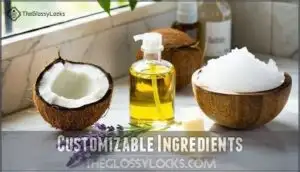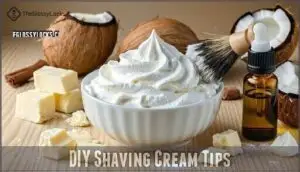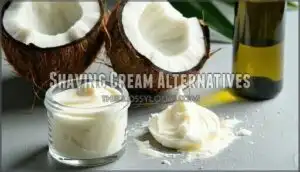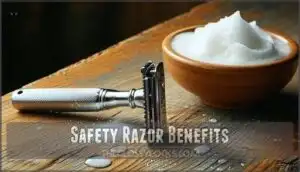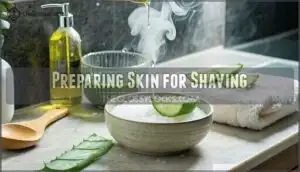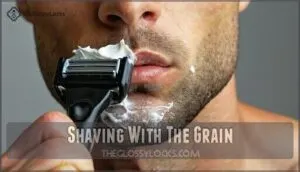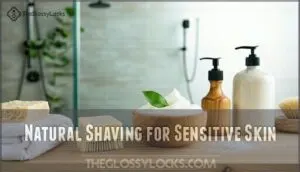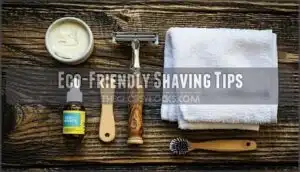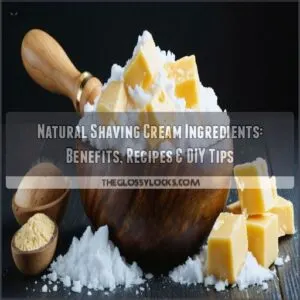This site is supported by our readers. We may earn a commission, at no cost to you, if you purchase through links.
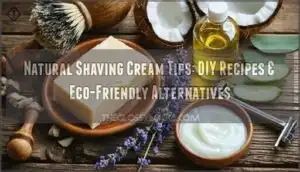
You’ll ditch harsh chemicals that irritate sensitive skin while saving money—homemade versions cost pennies compared to store-bought alternatives.
Simple ingredients like coconut oil, shea butter, and castile soap create luxurious lathers that moisturize as they protect.
Essential oils add aromatherapy benefits while aloe vera soothes post-shave irritation.
The best part? You control every ingredient, customizing recipes for your skin’s unique needs.
Whether you’re battling razor burn or seeking eco-friendly alternatives, natural options deliver superior results without compromising performance.
Your skin deserves this gentle upgrade, and the techniques ahead reveal game-changing secrets.
Table Of Contents
- Key Takeaways
- Natural Shaving Cream Benefits
- Choosing Natural Ingredients
- Homemade Shaving Cream Recipes
- Shaving Cream Alternatives
- Safety Razor Benefits
- Aftershave Natural Options
- Shaving Techniques for Men
- Natural Shaving for Sensitive Skin
- Eco-Friendly Shaving Tips
- Frequently Asked Questions (FAQs)
- Conclusion
Key Takeaways
- You’ll save money and protect your skin by making DIY shaving cream with simple ingredients like coconut oil, shea butter, and essential oils that cost pennies per shave compared to harsh chemical alternatives.
- Natural ingredients soothe sensitive skin better than commercial products – aloe vera provides cooling relief, honey offers antibacterial protection, and chamomile reduces inflammation without causing irritation.
- Safety razors paired with natural creams deliver smoother results while dramatically reducing plastic waste and eliminating toxic exposure from synthetic fragrances and preservatives.
- You can customize your shaving experience by adjusting ingredient ratios and choosing oils that match your skin type, creating personalized formulas that work better than one-size-fits-all store-bought options.
Natural Shaving Cream Benefits
You’ll love ditching those harsh chemical shaving creams that leave your skin feeling raw and your wallet empty.
Your face will thank you for making the switch to chemical-free shaving that actually works.
Natural alternatives give you better results while protecting both your skin and the planet from unnecessary toxins and waste, which is a natural approach.
Reduces Environmental Waste
Every year, millions of disposable razors end up in landfills, taking centuries to decompose.
By switching to zero waste shaving with sustainable ingredients and biodegradable razors, you’re dramatically reducing toxins in waterways.
Ecofriendly shaving cream in sustainable packaging cuts your environmental impact while supporting green living through simple waste reduction choices.
Cost-Effective Shaving
Your wallet will thank you when you ditch expensive shaving cream cans.
DIY shaving cream ingredients like shea butter and coconut oil cost pennies per shave compared to store-bought alternatives.
A homemade shave cream recipe using budget-friendly DIY ingredients creates months of smooth shaves.
Safety razors offer superior razor longevity with cost-saving blade alternatives that outperform disposables.
These natural alternatives also offer soothing sensitive skin benefits.
Soothes Sensitive Skin
Sensitive skin deserves gentle care, not harsh chemicals that leave you looking like a lobster after shaving.
Your skin shouldn’t pay the price for a smooth shave—choose gentle, natural alternatives instead.
Chamomile’s natural healing properties accelerate the recovery of minor cuts and wounds, making it great for soothing skin after shaving. Chamomile cream can be effective due to its anti-inflammatory properties.
Here’s how natural ingredients rescue irritated skin:
- Aloe application provides instant cooling relief for razor burn remedies
- Honey effects offer antibacterial protection while moisturizing deeply
- Oil sensitivity decreases with jojoba oils’ anti-inflammatory properties
- Natural shaving cream with calendula properties helps reduce inflammation and soothe skin irritation
Choosing Natural Ingredients
When you’re making your own shaving cream, the ingredients you pick can make or break your shaving experience, especially if your skin throws a tantrum at the slightest provocation.
You’ll want to choose gentle, nourishing ingredients that work with your skin type rather than against it, because nobody has time for razor burn that makes you look like you wrestled with a porcupine.
Considerations for Sensitive Skin
Your skin’s unique chemistry demands careful ingredient selection when crafting natural shaving cream.
Start with Patch Testing new formulations on a small wrist area 24 hours before full use. Choose Gentle Products like chamomile-infused oils over citrus extracts for Irritation Prevention and ideal Post-Shave Care.
| Ingredient Type | Sensitive Skin Safe | Potential Irritants |
|---|---|---|
| Base Oils | Jojoba, sweet almond | Coconut oil (some people) |
| Butters | Shea butter, cocoa butter | Heavily fragranced versions |
| Essential Oils | Lavender, chamomile | Peppermint, eucalyptus |
| Natural Additives | Aloe vera, oatmeal | Lemon juice, baking soda |
| Preservatives | Vitamin E oil | Synthetic fragrances |
Herbal Infusions for Skin
How can you transform ordinary herbs into skin-soothing powerhouses? Through herbal infusion, you’ll discover natural ingredients with incredible skin-regenerating properties that commercial products can’t match.
- Chamomile flowers steeping in warm oil, releasing golden anti-inflammatory compounds that calm irritated skin
- Calendula petals swirling in coconut oil, creating a vibrant orange elixir packed with healing properties
- Lavender buds infusing into shea butter, producing a purple-tinged cream with antiseptic skin benefits
These DIY recipes harness herbal properties through simple infusion methods, delivering targeted skin soothing without harsh chemicals.
Essential Oils for Shaving
Beyond herbal infusions, essential oils pack serious skin-soothing power for your shave routine.
Lavender and tea tree oil benefits include fighting bacteria while calming irritation. When blending, stick to 4% concentration in carrier oils like jojoba for safety concerns.
Match scent profiles to your skin types – sandalwood for inflammation, peppermint for cooling relief.
These natural ingredients transform ordinary essential oil shaving into spa-worthy self-care. Shaving also helps with skin exfoliation benefits.
Homemade Shaving Cream Recipes
You can whip up your own shaving cream that’s gentler on your skin and easier on your wallet than store-bought versions loaded with mysterious chemicals.
All you need is shea butter, a natural oil like sweet almond or coconut, and maybe a few drops of your favorite essential oil to create a fluffy, moisturizing cream.
That’ll give you the smoothest shave of your life.
Customizable Ingredients
Creating your own DIY shaving cream means you can mix and match ingredients like coconut oil and shea butter to match your skin type perfectly.
Essential oils add herbal properties—tea tree fights bacteria while lavender soothes irritation.
Try different oil combinations until you find your sweet spot, then make recipe adjustments as needed for the ultimate personalized blend.
Many people find coconut oil effective for shaving.
Avoiding Harsh Chemicals
Making your own chemical free shaving cream puts you in control of what touches your skin. Commercial products often hide harsh chemicals behind fancy marketing, but you’ll know exactly what’s in yours.
Here’s what to avoid when choosing natural ingredients:
- Parabens that disrupt hormones and cause skin irritation
- Sulfates that strip your skin’s natural protective oils
- Synthetic fragrances linked to allergic reactions and toxin exposure
- Artificial preservatives that can trigger contact dermatitis
- Petroleum-based ingredients that clog pores and feel greasy
Label reading becomes your superpower for chemical-free living. Look for non toxic shaving ingredients like shea butter, coconut oil, and essential oils. These chemical alternatives actually nourish your skin instead of just sitting on top. Ingredient awareness helps you create safer products that work better than store-bought versions while supporting your overall health. Using these recipes can lead to cost-effective savings compared to store-bought alternatives.
DIY Shaving Cream Tips
You’ll want to nail your ingredient ratios and whipping techniques for the perfect consistency.
Start with equal parts solid oils to liquid – this prevents your homemade products from being too runny or thick.
| Component | Ratio | Storage Tips |
|---|---|---|
| Shea Butter | 1/2 cup base | Cool, dry place |
| Carrier Oil | 1/3 cup liquid | Airtight container |
| Essential Oils | 10-15 drops | Dark glass bottles |
| Shelf Life | 6-12 months | Label with dates |
Whip your base ingredients until fluffy – this creates that creamy texture you’re after.
Remember, natural shaving cream with high oil content can cause drain clogging, so use sparingly.
Your diy shaving cream recipe should feel silky, not greasy.
Shaving Cream Alternatives
If traditional shaving creams aren’t working for you, simple kitchen staples can save the day.
You’ve probably got coconut oil, olive oil, or shea butter sitting in your pantry right now—and they’ll give you a smoother shave than most store-bought products.
Coconut Oil for Shaving
Coconut oil’s antibacterial and antifungal properties make it perfect for coconut oil shaving.
Apply this natural shaving cream to damp skin for maximum coconut oil benefits.
Its thick consistency creates a protective barrier while moisturizing.
However, coconut oil can clog your razor, so rinse frequently.
The tropical scent isn’t for everyone, but it delivers a smooth shave cream experience.
Olive Oil for Moisturizing
Olive oil brings serious moisturizing power to your shaving routine.
Rich in antioxidant properties, it’s perfect for dry skin types who shave frequently.
Apply this natural ingredient to damp skin using gentle circular motions.
The anti-inflammatory benefits make olive oil an excellent base for DIY shaving cream, delivering smooth results without harsh chemicals found in commercial products.
Shea Butter for Hydration
Think of shea butter as your skin’s best friend after a tough shaving session.
This creamy powerhouse delivers deep hydration while forming a protective barrier against razor burn and irritation.
Here are three key shea butter benefits for your DIY shaving cream:
- Deep moisturizing – Shea butter’s fatty acids penetrate skin layers, creating lasting hydration that beats most commercial products
- Anti-inflammatory relief – Natural compounds soothe redness and calm freshly shaved skin without stinging
- Universal compatibility – Works for all skin types, including sensitive and acne-prone skin, without clogging pores
Safety Razor Benefits
Safety razors aren’t just trendy throwbacks—they’re your ticket to a cleaner shave without the environmental guilt.
You’ll ditch the plastic waste and harsh chemicals while getting a smoother result that won’t irritate your skin like those fancy multi-blade cartridges.
Reduces Waste and Toxins
You’re ditching a wasteful habit that’s been quietly harming both you and the planet.
Safety razors slash toxin exposure from harsh chemicals while dramatically cutting plastic waste. One razor lasts decades, not days.
Many prefer to buy a quality safety razor for its longevity.
| Traditional Razors | Safety Razors |
|---|---|
| Plastic cartridges create mountains of waste | Metal construction lasts for generations |
| Chemical-laden strips irritate sensitive skin | Chemical free shaving protects your health |
| Constant repurchasing drains your wallet | Sustainable shaving saves serious money |
This change promotes a more sustainable shaving practice, which is better for both you and the environment, by reducing plastic waste.
Smooth Shaving Experience
You’ll discover that safety razors deliver incredibly smooth shave cream experiences when paired with natural ingredients.
The single, sharp blade cuts cleanly through hair without tugging, while natural oils help your skin stay hydrated throughout the process.
You can find a suitable razor for purchase online.
Here’s what makes the difference:
- Razor Glide improves with natural oils that create a protective barrier between blade and skin
- Blade Sharpness stays consistent, requiring fewer passes over sensitive areas
- Exfoliation Importance becomes clear as dead skin cells lift away naturally during each stroke
- Shaving Angle matters less when smoother skin reduces friction and drag
- Skin Hydration lasts longer with these shaving techniques and natural shaving tips
Aftershave Natural Options
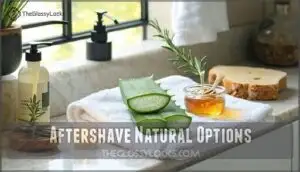
Your skin deserves better than stinging, chemical-laden aftershaves that leave you wincing after every shave.
Natural alternatives like aloe vera gel, raw honey, and DIY herbal blends soothe irritation while actually nourishing your skin instead of drying it out.
Aloe Vera for Soothing
Your skin craves the gentle embrace of aloe vera’s cooling properties after shaving.
This natural wonder contains anti-inflammatory compounds that calm irritation while delivering deep hydration. Apply fresh aloe gel directly to clean skin, or blend it with coconut oil for enhanced moisturizing power.
| Aloe Benefits | Application Method | Storage Tips |
|---|---|---|
| Reduces inflammation | Apply to damp skin | Refrigerate fresh gel |
| Heals micro-cuts | Gentle circular motions | Use within 1 week |
| Provides deep hydration | Mix with natural oils | Store in dark container |
| Soothes razor burn | Pat, don’t rub | Keep away from heat |
Honey for Hydration
Raw honey works like a natural humectant, pulling moisture from the air into your skin.
Its honey benefits include antibacterial properties that prevent infection while deeply hydrating.
For honey application, mix a tablespoon with your natural shaving cream or diy shaving cream recipe.
Honey combinations with natural ingredients like aloe create powerful skin hydration boosters. Tea tree oil can also be beneficial.
Try honey masks post-shave for ultimate nourishment.
Natural Aftershave Recipes
Five simple herbal aftershave recipes can transform your post-shave routine into a skin-soothing ritual. These DIY ingredients work better than store-bought products, especially for sensitive skin.
- Classic Witch Hazel Base – Mix witch hazel with aloe vera and jojoba oil for instant cooling relief
- Spiced Bay Blend – Combine bay, clove, and cedarwood essential oils with vegetable glycerin for antimicrobial protection
- Aftershave Butter – Whip shea butter with sweet almond oil and lavender for deep moisturizing
- Tea Tree Fresh – Infuse peppermint and tea tree in distilled water for natural antiseptic benefits
- Recipe Customization – Add vitamin E and skin-soothing herbs like chamomile for enhanced healing
Store these natural remedies in dark amber bottles. Your aftershave oil creations need refrigeration for maximum freshness. These storage solutions keep natural ingredients potent longer.
Shaving Techniques for Men
Getting the perfect shave with natural cream starts with solid technique—no shortcuts here.
You’ll want to prep your skin properly, follow your hair’s natural growth pattern, and keep that razor in top shape for consistently smooth results.
Preparing Skin for Shaving
Before your shaving routine begins, proper skin hydration and preparation make all the difference.
Start with warm water to soften whiskers and open pores—it’s like giving your face a gentle wake-up call. For sensitive skin shaving, gentle exfoliation removes dead cells without irritation.
| Preparation Step | Natural Ingredients | Benefits |
|---|---|---|
| Exfoliation Importance | Sugar scrub, oatmeal | Removes dead skin, prevents ingrowns |
| Hydration Methods | Aloe vera, glycerin | Softens hair, protects skin |
| Pre-shave Oils | Jojoba, coconut oil | Creates protective barrier, reduces friction |
Apply pre-shave oils with gentle brush application—this creates a smooth canvas for your razor.
Shaving With The Grain
Going against the grain might feel rebellious, but your whiskers won’t thank you for it. Hair mapping reveals your natural growth patterns, helping you avoid ingrown hairs and skin sensitivity issues.
Proper razor angle and blade sharpness make following these patterns effortless in your shaving routine. Pre-shave oil application can also substantially reduce irritation.
- Map your hair growth – Run fingers across stubble to identify direction patterns
- Adjust your razor angle – Keep blade at 30-45 degrees following hair direction
- Modify shaving techniques – Use short, gentle strokes with consistent pressure
- Update shaving habits – Always follow grain first, then consider cross-grain passes
Razor Maintenance Tips
Your safety razor deserves tender loving care to deliver smooth shaves without razor burn or nicks.
After each use, rinse the blade thoroughly under hot water for proper blade cleaning, then pat the handle dry to prevent rust.
Store your reusable razor blades in a dry spot—moisture breeds trouble.
Replace dull blades promptly; fighting with worn edges causes cuts and irritation, which can be avoided with proper care and by storing them in a dry spot to prevent rust.
Natural Shaving for Sensitive Skin
If you’ve got sensitive skin, you know that traditional shaving can feel like scraping sandpaper across your face.
Natural shaving methods offer a gentler approach that soothes irritation while giving you a smooth shave without the harsh chemicals that make your skin angry, providing a solution for those with sensitive skin to achieve a smooth shave with natural methods.
Gentle Exfoliation Methods
Pamper your skin before shaving with sugar scrubs or oatmeal exfoliation to remove dead cells and prevent ingrown hairs.
Gentle cloths work wonders for sensitive skin, while enzyme peels offer deeper cleaning without harsh scrubbing.
Dry brushing boosts circulation and preps your face perfectly, creating the ideal canvas for razor burn-free shaving with the help of these natural ingredients, including oatmeal exfoliation.
Soothing Skin Irritation
When your skin feels like it’s on fire after shaving, you’re dealing with common irritation causes like dull blades or poor Post-Shave Care.
Natural Remedies work wonders here—aloe vera shaving treatments calm angry skin instantly. Try skin-soothing herbs like chamomile or calendula for sensitive skin relief.
These gentle solutions tackle shaving irritation without harsh chemicals, helping your Skin Sensitivity issues heal naturally while Preventing Bumps from forming, and utilizing Natural Remedies.
Natural Remedies for Razor Burn
When razor burn strikes, you’ll want relief fast.
Aloe Vera delivers soothing effects within an hour, while Honey Benefits include natural antibacterial healing. These natural ingredients work better than harsh chemicals for sensitive skin.
Here are proven Oil Soothers and remedies:
- Aloe vera shaving gel – Apply directly for instant Cooling Effects
- Coconut oil blend – Mix with tea tree oil for antimicrobial protection
- Herbal Compress with chamomile tea bags – Press on affected areas
- Witch hazel toner – Natural astringent that reduces inflammation
- Oatmeal paste – Creates protective barrier while skin-soothing herbs work
Eco-Friendly Shaving Tips
Making the switch to eco-friendly shaving doesn’t require a complete lifestyle overhaul – small changes can make a big difference for both your skin and the planet.
You’ll discover that sustainable shaving practices often save money while reducing your environmental footprint, proving that going green doesn’t mean sacrificing quality, and this can lead to a more eco-friendly approach.
Reducing Plastic Waste
Traditional disposable razors contribute tons of plastic waste annually, but you can break free from this cycle.
Switch to refillable containers for natural shaving cream instead of aerosol cans, and choose safety razors with razor recycling programs through brands like Albatross or TerraCycle.
Opt for minimalist packaging when buying shaving supplies, as these plastic alternatives support waste reduction while maintaining your grooming routine.
Making plasticfree shaving and zerowaste shaving achievable for ecoconscious choices in sustainable living is the ultimate goal, allowing you to make a positive impact on the environment.
Biodegradable Packaging
When you’re choosing eco-friendly shaving products, look for compostable packaging and seed paper labels that’ll actually grow into plants.
Many brands now use recycled materials and minimalist packaging designs.
Package-free options like refillable containers make zerowaste shaving totally doable.
These plasticfree shaving alternatives prove that minimal packaging doesn’t mean sacrificing quality – just smart choices.
Sustainable Shaving Practices
Adopting Zero-Waste Shaving transforms your daily routine into an eco-friendly ritual.
You’ll reduce your Carbon Footprint by choosing safety razors with minimal packaging and natural alternatives like solid shaving bars.
These Ethical Sourcing practices support the Circular Economy while conserving water.
Ecofriendly shaving isn’t just trendy—it’s your ticket to shaving sustainability that actually makes a difference.
Frequently Asked Questions (FAQs)
What can I use as a natural shaving cream?
Don’t think commercial creams are necessary for smooth shaves.
You can whip shea butter with coconut oil, use aloe vera gel, or try coconut oil directly on damp skin for natural lubrication.
What is the 3:1:1 rule for shaving cream?
The 3:1:1 rule means you mix three parts shaving cream, one part oil, and one part water.
This combo gives you a creamy lather, smooth glide, and happy skin—like a spa day for your face!
How long does homemade shaving cream last?
Sarah’s homemade shea butter cream sat in her bathroom cabinet for eight months, still creamy and effective.
Your homemade shaving cream typically lasts six to twelve months when stored properly in a cool, dry place without water exposure, which helps it remain effective and creamy.
Can natural shaving cream clog bathroom drains?
Yes, natural shaving cream can clog drains because it contains high amounts of solid oils like shea butter. Use sparingly and consider your plumbing when rinsing off the cream.
Whats the best storage method for DIY cream?
Store your DIY shaving cream in a cool, dry place away from direct sunlight.
Use an airtight container to prevent oxidation and moisture.
It’ll stay fresh longer when kept properly sealed and stored.
How much homemade shaving cream per shave?
A teaspoon’s worth creates your shaving sanctuary.
You’ll need just a dime-sized dollop of homemade cream per shave—it spreads beautifully and goes further than you’d think, making your investment last.
Does natural shaving cream work for legs?
Natural shaving cream absolutely works for legs.
You’ll get smoother results than traditional products since ingredients like shea butter and coconut oil provide superior glide and moisturization for larger surface areas.
Conclusion
Embracing these natural shaving cream tips transforms your bathroom routine from chemical warfare to spa-like sanctuary.
You’ve discovered how coconut oil, shea butter, and essential oils create luxurious lathers while protecting your wallet and skin.
Whether you’re crafting homemade recipes or switching to eco-friendly alternatives, you’re investing in long-term skin health.
Your razor will glide smoother, irritation will fade, and you’ll feel good knowing every ingredient serves a purpose.
Start small, experiment with different combinations, and watch your skin thank you, as you enjoy the benefits of long-term skin health and a smoother shave with essential oils.
- https://www.stingrayrazor.com/blog/embracing-nature-the-benefits-of-using-organic-based-shave-cream
- https://pureshave.co.uk/natural-shaving-cream/
- https://brickellmensproducts.com/blogs/grooming-manual/113911107-why-an-all-natural-shaving-cream-for-men-is-superior
- https://www.heliotropesf.com/blogs/news/why-we-love-these-best-natural-shaving-products
- https://www.tomsofmaine.com/blogs/natural-products/3-natural-shaving-cream-alternatives-you-probably-already-have-at-home


